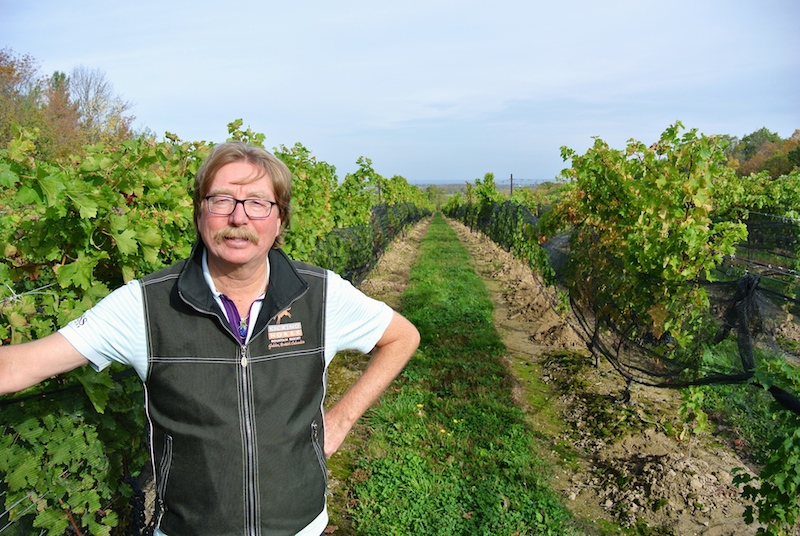
By Rick VanSickle
It’s a warm autumn day on the Beamsville Bench and we’re standing at the highest point of the Heron Pond Benchland Vineyard looking across Lake Ontario toward the big city skyline of Toronto..
We’re eating plump, juicy ready-to-pick Chardonnay grapes like crazy, trying to memorize flavours to compare them to grapes further down the gentle slope and from different aspects on the 50-acre site.
Rennie Estate owner Graham Rennie is looking for the best Chardonnay blocks that will make up his Christine Chardonnay cuvee from the 2017 vintage. Up here, on the top shelf of the sloping Niagara escarpment, the berries are ripe for the picking but there is still enough acidity that will bring that freshness and balance Rennie wants in the only single-vineyard white wine he makes from the estate.
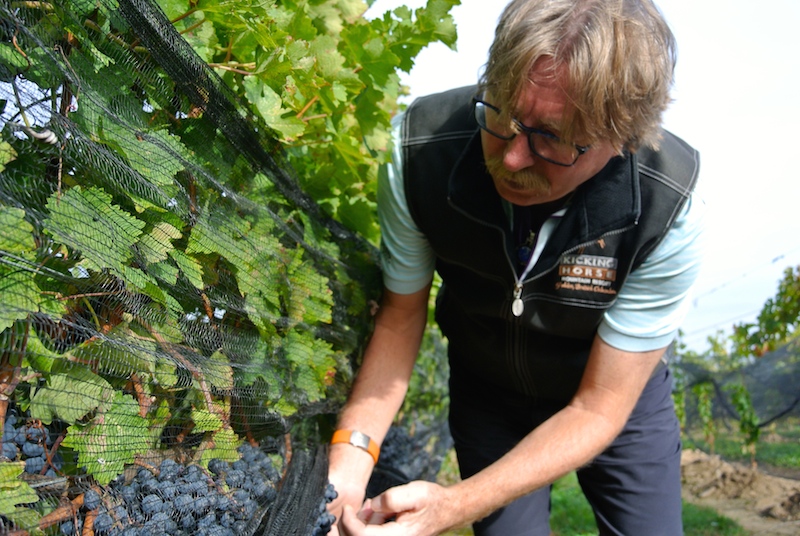
It has been a wild growing season. A cool, wet summer, damaging hail on the bench, a needed blast of heat in the fall coupled with more late rain has provided that old proverbial roller-coaster ride for grape growers. Rennie is ready to rock on the Chardonnay; it’s at its peak of perfection. There will have to be some work to do to rid the vines of the dreaded ladybugs that have come out in full force, and careful sorting to separate out what the hail damaged in the summer and the birds pecked away at on the vines without netting in the fall, but the fruit is gorgeously ripe and concentrated and will provide delicious wine in the coming months.
The slope of the bench and the constant airflow from Lake Ontario provides a unique microclimate here, which cools the vineyard during the hottest summer months and facilitates the removal of cold air during the winter months. The character of Rennie’s wines is influenced by the considerable limestone deposits found within the calciferous clay and loam rich soils on this site, which is carved out of the escarpment and forests that surround the vineyard.
The Heron Pond Benchland Vineyard is one of the oldest on the bench, and was producing fruit as early as the 1960s. The vineyard is surrounded to the east by woodlands and ponds, to the north by Lake Ontario, and to the south by the protective shield of the Niagara escarpment.
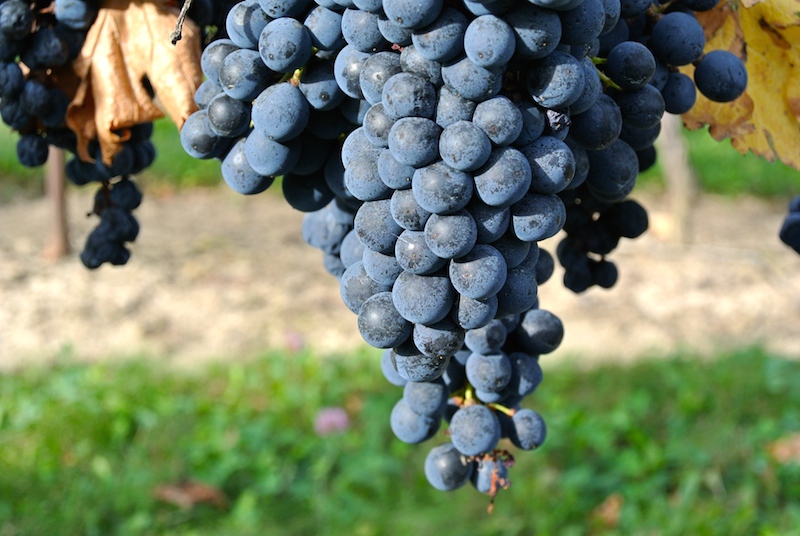
In 1999, Rennie, his wife Christine and family planted five varietals. They sourced Chardonnay (Dijon clone 76 ), Pinot Noir (Dijon clone 113 ) Cabernet Sauvignon (clone 169), Cabernet Franc (clone 210) and Merlot (clone 184) from the Mercier nursery in France. The vineyard was planted with spacing at 1,275 vines per acre with 8 feet wide rows. The varietal mix is 28% Pinot Noir, 17% Chardonnay, 20% Merlot, 20% Cabernet Franc and 15% Cabernet Sauvignon, most of which is sold to commercial wineries for premium bottlings.
A choice portion of the harvest is carefully diverted to Rennie’s namesake brand, Rennie Estate Vineyard, where he makes Chardonnay, Pinot Noir, a ripasso style red blend, an appassimento style red blend and the ultimate single-varietal super appassimento wine that has come to define his style of winemaking using an innovative grape drying chamber Rennie houses at Malivoire Winery where the wines are made (and sold) under the steady hand of Shiraz Mottiar.
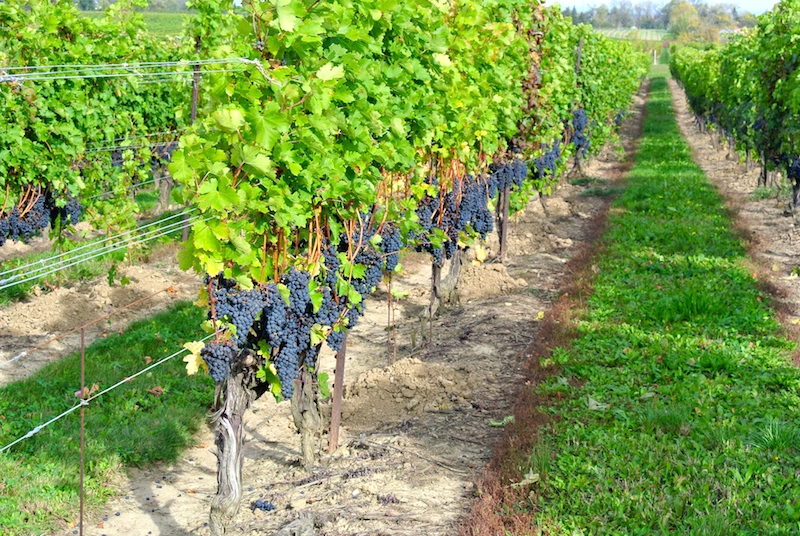
As we traverse the entire vineyard on this day, we stop at each defined block of fruit and taste the fruit. In the lower portion of the vineyard, where intense heat pounds down on the grapes, the Chardonnay shows more tropical notes and sits at slightly higher Brix (sugar content). The Cabernet, Cabernet Franc and Merlot is plump and juicy and already some of the crop has been harvested and sent to the custom drying chamber at Malivoire.
For his own wines “I have the ability to go row by row and berry select,” Rennie says, who spends a great deal of time walking the entire vineyard and tasting grapes, waiting and watching for the optimum moment to pick and getting advice from his winemaker Mottiar, who just happens to live and own an adjacent vineyard and home on the bench.
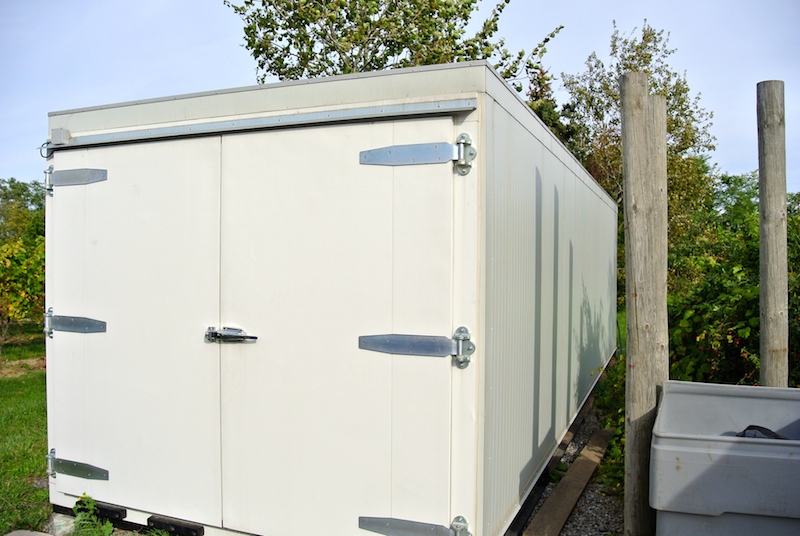
A short drive down Old Highway 8, at the Malivoire winery and tucked into a corner near the crush pad, the drying chamber Rennie developed with engineers at the Vineland Research and Innovation Centre sits inconspicuously. It doesn’t look like much.
It’s built to fit on a flatbed truck so it can be moved from place to place if the need arises.
It has been a labour of love for Rennie who has always wanted to focus on appassimento winemaking and has used many different improvised methods to dry the grapes until developing his unique chamber, which cost him $80,000.
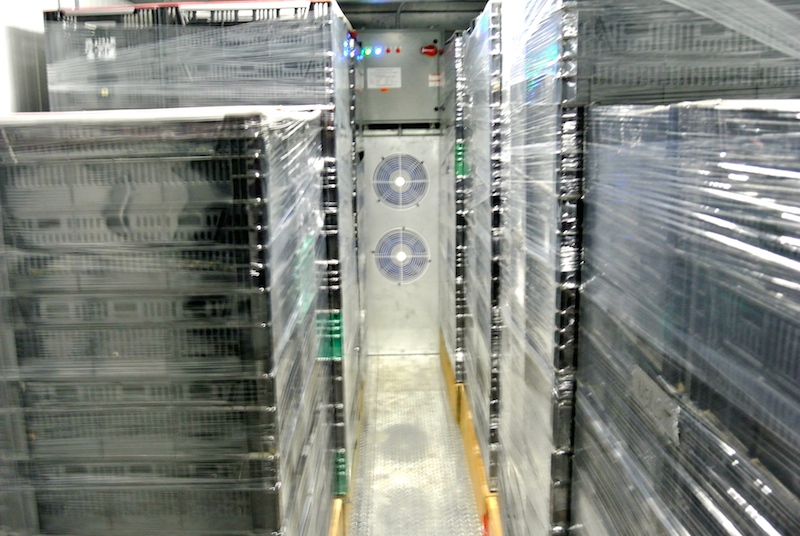
It’s not practical in the climate of Niagara to the use the traditional techniques of drying grapes employed in the Italian wine region of Amarone, so Rennie’s temperature and humidity controlled drying chamber replicates the process. The air is blown into the chamber where the fruit (up to seven tonnes) is stacked in crates and wrapped in plastic with the top layer topped with a lid that has holes in it. Vacuums at the bottom of the chamber suck the air through the stacked crates for a continuous flow of air passing evenly through all the grapes.
“There’s a fair bit of art and science in every bottle,” muses Rennie.
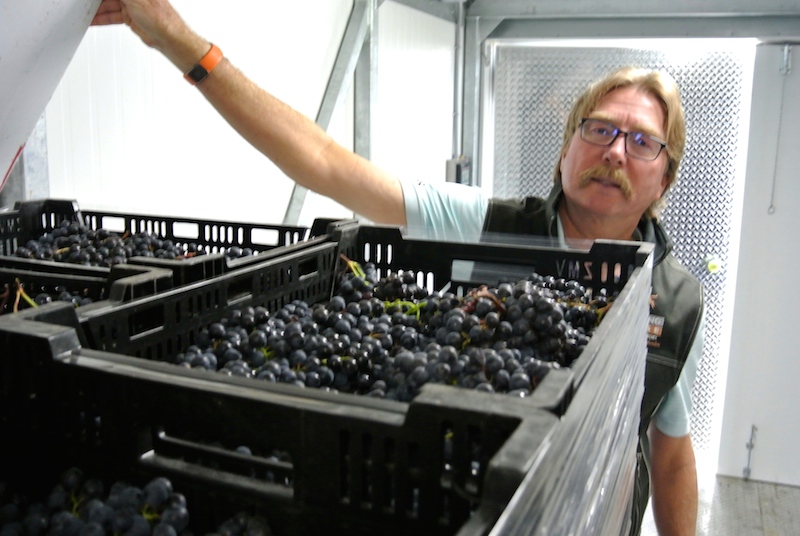
The system eliminates any potential for mould and rot and can be controlled through the entire process. In an ideal vintage, Rennie wants his Bordeaux grapes picked at around 25 Brix and dried to achieve 28 to 28.2 Brix in a window of time between 80 and 105 days in the chamber. The master control panel in the chamber constantly records the number of days needed to achieve the ripeness and concentration Rennie wants in the grapes and can be adjusted throughout the process to fall within the desired window.
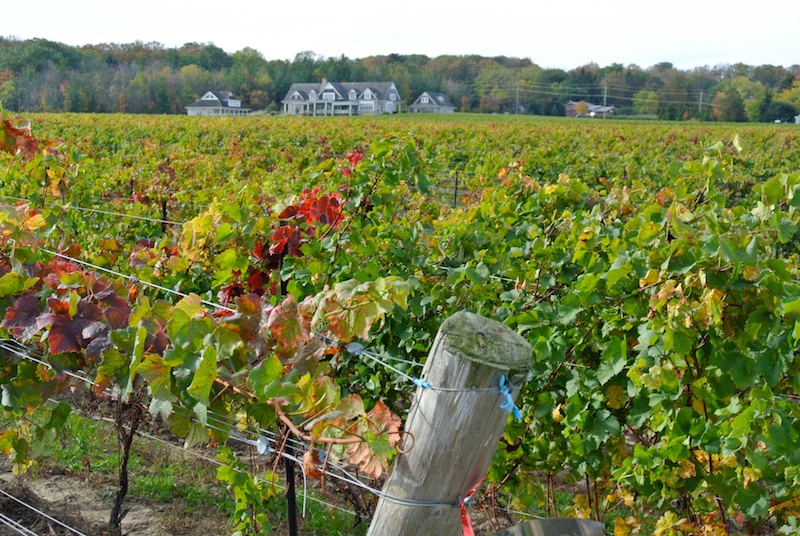
Back at the Rennie estate, it’s time to taste the fruit of all his labour and innovation, in the comfort of the family home that stands majestically overlooking the vineyards and provides a stunning vista that stretches across Lake Ontario on a clear day.
Here is what we tasted.
Note: Rennie’s wines are available through the retail store at Malivoire winery.
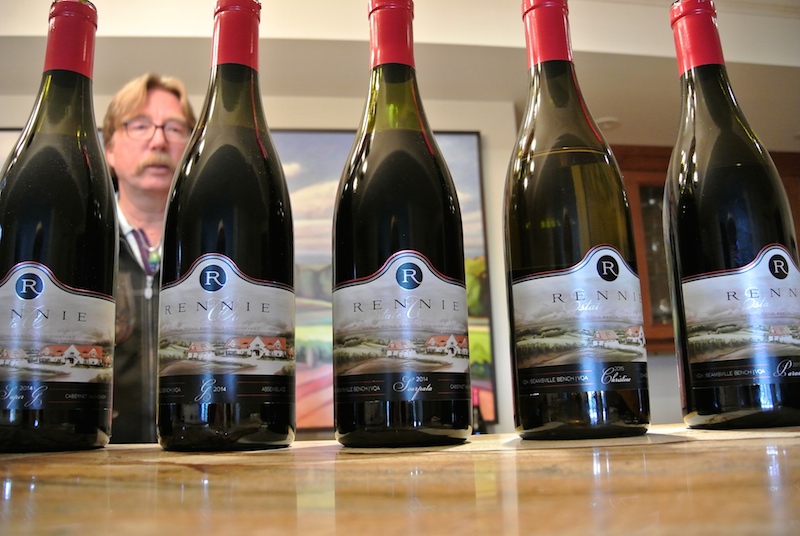
Rennie Estate Paradox 2015 ($40, Nov. 4 release at Malivoire, 89 points) — The Pinot Noir fruit is whole cluster pressed and bottled unfiltered. It has a brambly, cherry-soaked nose with savoury/earth notes, a seam of minerality, kirsch and barrel spices. There ‘s plenty of cherry fruit on the palate but also beetroot, mineral, anise and spice with a firm bed of tannins to carry it for 4+ years in the cellar. Should be laid down for at least two years.
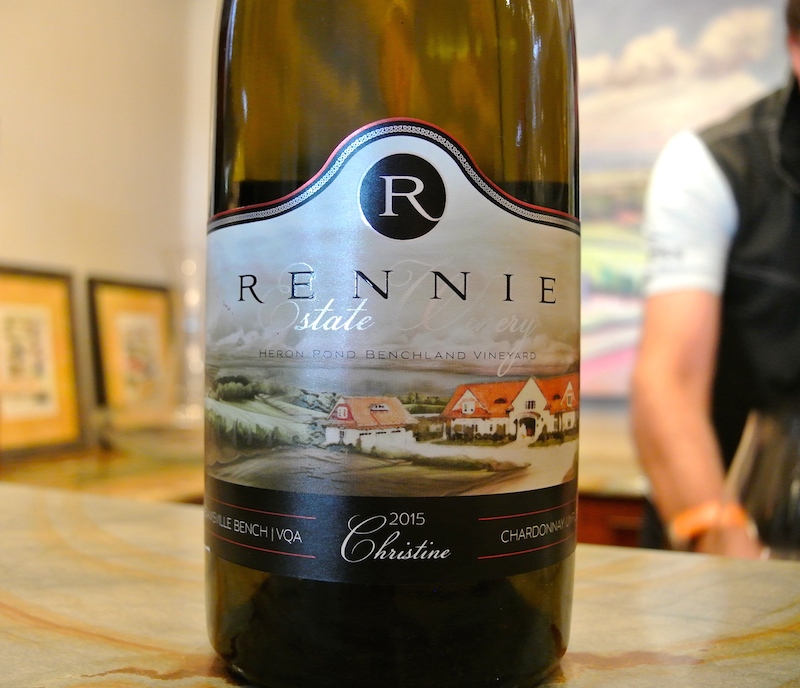
Rennie Vineyard Christine Chardonnay 2015 ($40, available now, 91 points) — This Chardonnay is whole cluster pressed, unfiltered and spends 17 months in French oak, 50% old, 50% new barrels. It has a rich and voluptuous nose of baked apple, creamy pear, lemon accents and elegant oak stylings. This is a robust style of Chardonnay with richness of fruit and the spice to match. Look for creamy orchard fruit and barrel oak spices with a fair amount of acidity to keep it balanced and fresh through the finish.
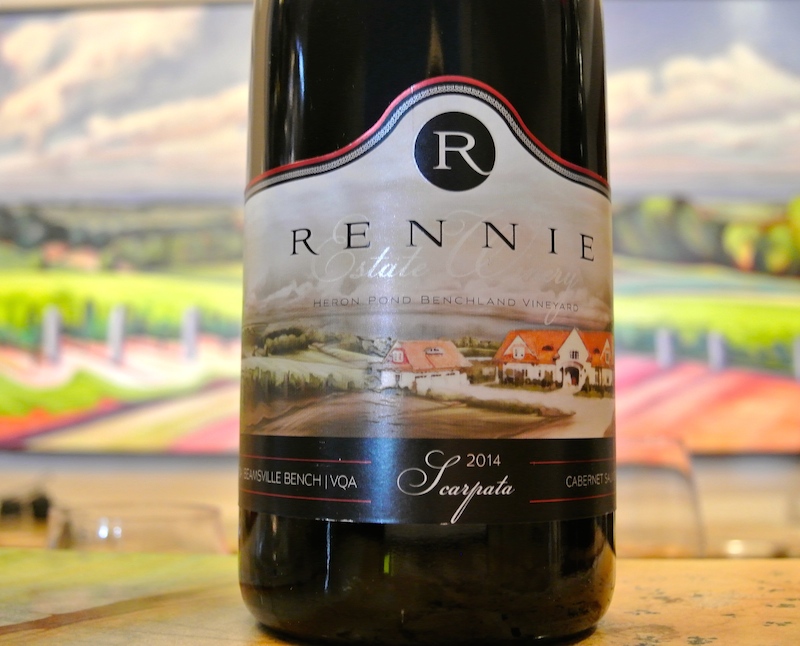
Rennie Estate Scarpata 2014 ($45, available now at Malivoire, 90 points) — This is Rennie’s ripasso style red with the Cabernet Sauvignon passed over the skins of the “G” assemblage to gain complexity and concentration. The wine approaches the 15% abv level. The nose shows a range of black currants, blackberries, sweet tobacco and caramel spice notes. It’s quite concentrated on the palate with dark fruits, lovely spicy notes, evident tannins, some heat with length through the finish. Somewhat disjointed with the potential to come together with time in the cellar. Like all Rennie reds, you have to wait for them.
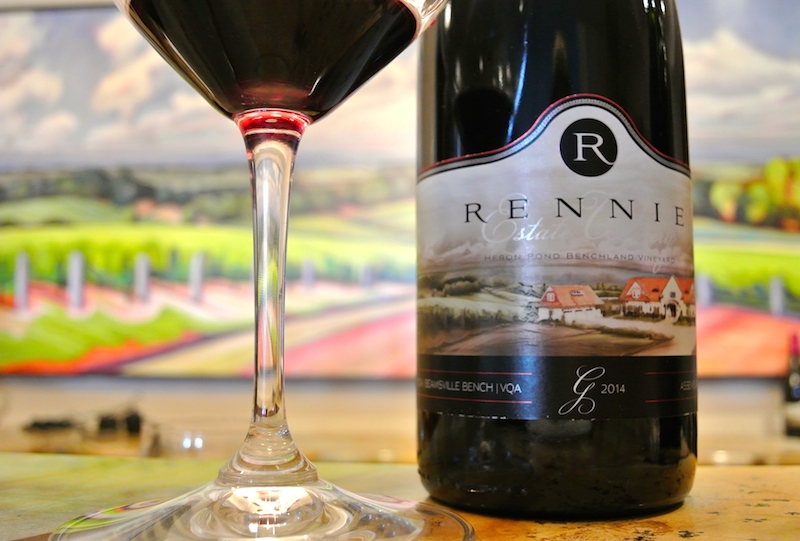
Rennie Estate G 2014 ($60, available at Malivoire now, 92 points) — The G is an assemblage of Merlot, Cabernet Franc and Cabernet Sauvignon with the three varieties dried in Rennie’s chamber for up to 105 days to a maximum of 28.5 Brix and finished at 15.5 abv. Winemaker Shiraz Mottiar takes the best from the vineyard with this appassimento style blend with Merlot the dominant grape and Cab Franc the smallest portion. It shows a highly concentrated nose of kirsch, cassis, anise, black licorice, graphite and lavish oak spices. It’s soft and hedonistic on the palate with complexity and texture that highlights ripe dark fruits and rousing barrel spice notes. This is a highly structured wine with depth and power with enough juicy fruit to reduce the heat of the alcohol, but it most definitely should find room in a dark corner of your cellar for further integration, say 4+ years, or try now with a big honking T-bone steak. Like your wines big? Here you go, but, wait … there’s bigger (read on)
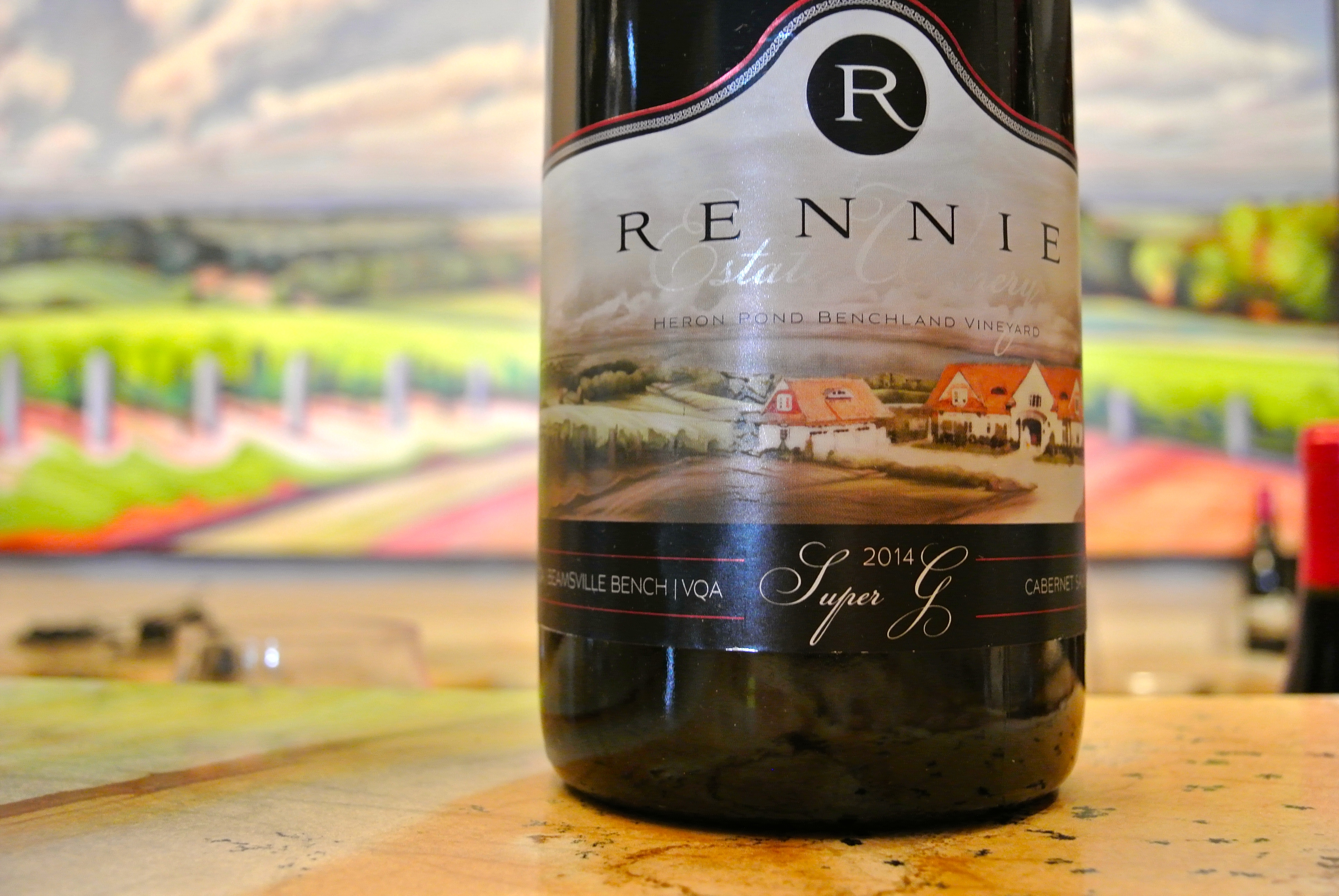
Rennie Estate Super G 2014 ($100, Nov. 4 release at Malivoire, 50 cases available, 93 points) — You can dismiss Rennie for wanting to craft these big, bold wines in Niagara where the trend is to build more finessed, delicate wines that highlight the cool climate of Niagara. But, that would not be true to what he truly likes to drink and serve his friends and family. Truth is, Rennie loves highly concentrated Amarone style wines; big, seductive wines that have both power and concentration. When he decided to expand from wine grower to winemaker, it was Amarone he looked to for his inspiration and set out to find a way to dry his grapes appassimento style in Niagara to get the concentration and complexity he wanted from his Bordeaux varietal red grapes. He is of the firm belief that you can replicate the air-drying grape process used in Verona and apply it to better grapes in Niagara from a premium growing site. “You should be able to make better wines,” he says. The Super G is the pinnacle of that thinking, the best expression of his site, from the top Cabernet Sauvignon grapes, 100% of the fruit dried for 86 days, picked at 22 Brix and dried to 27.6 Brix (30% weight loss), then tucked away in all new French oak barrels for 22 months and finished at 16% abv. This is Rennie wine, the essence of Rennie.
So, redundant to say it’s big, but it’s BIG; a showy and concentrated nose of black current jam, blackberries, cherries, graphite, earth, tar, bramble and a crazy array of barrel spice notes. It’s so tight right now and needs time, but vigorously swirl that baby and the power reveals itself on the palate with waves of bountiful dark fruits, kirsch and raspberry accents, and a wall of tannins assertive enough to curl your tongue until the next sip. This wine was built for the long haul. The beauty inside is only beginning to show itself; those fine oak spices, the sweet tobacco notes and the mélange of lush fruit. But, let’s face it, this needs time to bring all those moving parts into harmony, at least 5+ years. Then you’ll enjoy a hell of fine wine, inspired by tradition and built from innovation.





We bought a bottle of Rennie R “Assemblage.” What appetizers do you suggest for a pairing?
I would suggest bold charcuterie cuts and bold cheeses. You need something to stand up to the richness, tannins and bold nature of those appassimento wines.